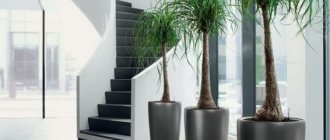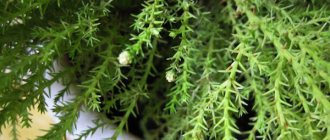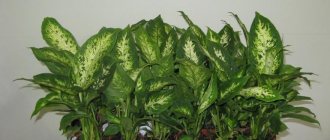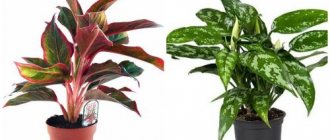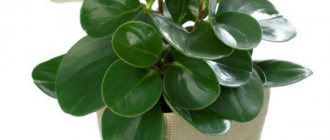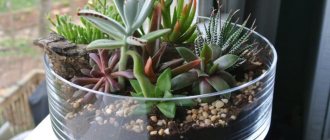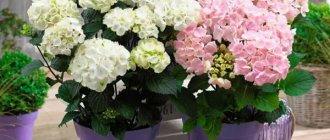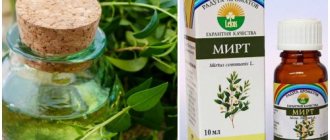Nolina (aka Bocarnea) is an exotic succulent native to the arid Mexican deserts. It will be appreciated by lovers of everything unusual. The thickened trunk of this plant resembles an elephant's leg. Therefore, people call nolina “elephant’s foot”; it is also called “bottle tree”. The plant looks noble, perfectly decorates the interior and is deservedly popular among lovers of indoor floriculture.
Description of Nolina
In total, more than 30 species of tree have been described, but only nolina bent is cultivated at home. This indoor flower grows in nature like a real tree . It has a shallow root system, which is typical of all plants forced to exist in an arid climate. To survive in desert conditions, the nolina trunk forms a caudex at the bottom - a special cavity in which moisture accumulates.
Dense leathery leaves grow in a lush bunch at the top of the trunk. They are long and narrow, falling down. As you can see in the photo of the “bottle tree” indoor plant, the crown forms a real fountain. When purchasing in a store, you need to take into account that nolina continues to grow for many years and over time may not fit on the windowsill. At home, the “elephant’s foot” does not bloom, and this is not expected from it. The tree already looks very decorative.
Indoor types of bottle trees
Several types of bottle tree are suitable for growing indoors. All lovers of exotic plants need to know their differences and features.
- Beaucarney Parry
has a tall trunk and is suitable for growing in spacious rooms with high ceilings. The serrated leaves grow from a rosette that can split into two if deformed. - " Guatemalan tail
" is called the domestic bottle tree with a lush crown. Some varieties of this variety are distinguished by striped leaves. - Beaucarnea thin
doesn't really live up to its name. Its trunk looks like a huge pear buried in the ground. The pattern on the bark resembles a turtle shell. - Bocarnea reflexum
does not grow more than 50 cm. This plant can be an excellent decoration for the interior, the leaves of which can curl into a spiral, and the trunk takes on bizarre shapes. - The standard nolina
grows very slowly, and at first its trunk looks like a hemisphere. Over time, it levels out and resembles a thick bottle with a narrow neck.
Necessary conditions for cultivation
A plant is a living creature that needs to create certain conditions for its growth and development. The more the microclimate of your apartment resembles the nolina’s natural habitats, the better it will feel. Consider parameters such as lighting, temperature and humidity.
Lighting
Like all tropical plants, bocarney needs good lighting. Due to the fact that the trunk is covered with hard bark and the leaves are leathery, the tree tolerates direct sunlight , so it is advisable to place it in the most illuminated place. This could be a south or southwest window sill.
If the nolina is already large and stands on the floor, the pot with the plant should be brought close to the window. If there is a lack of light, nolina will begin to reach for its source. To prevent the trunk from bending during growth for this reason, turn the pot with nolina a few degrees from time to time. If curvature has already occurred, turn the plant with the other side towards the light.
Temperature and humidity
Since nolina is a desert plant, it loves warmth. In summer, it will be comfortable at a temperature of 23-25 degrees; in winter, the plant tolerates a temperature drop of up to 15 degrees. Elephant foot tolerates lower values worse. If the temperature is below 7 degrees, the plant may die . In summer, in dry and sunny weather, Nolina feels great in the fresh air.
Considering where the bottle tree grows in nature, the air humidity level may not be controlled. It doesn't matter to succulents. Nolina feels great in any humidity and does not need additional spraying. If you want to spray the leaves to remove dust from them, do it carefully, being careful not to get it on the trunk. In bark saturated with moisture, rotting may begin.
Where to buy bocarney
You can purchase an adult copy of the southern tree in nurseries or online stores. But its cost will be quite high. It depends on the age of the plant, its type, height and material of the pot. For example, a tree 100 cm high will cost approximately 5500-6000 rubles. It will be much cheaper to buy seeds - their price is 60 rubles, but growing an adult nolina will be quite difficult and long.
Plant care
Bokarneya needs regular watering, periodic fertilizing and replanting. These procedures provide the plant with moisture and nutrients and give it opportunities to grow. Caring for nolina at home is quite simple:
- Under no circumstances should watering be excessive. Excessive moisture content in the pot is a direct path to ruining the nolina. Do not forget that in its natural environment the plant receives water extremely rarely. In spring and summer, it is enough to water the tree twice a month; the water is immediately drained from the pan. In winter, the plant can do without watering at all, especially if kept in a cool room . The need to moisten the soil can be indicated by wrinkling of the trunk. In this case, lightly water the bottle tree.
- Fertilizing is done only in spring and summer, during the period of active growth. It is necessary to use special fertilizers for cacti, dissolving them in water for irrigation. It is enough to fertilize nolina 2-3 times a month.
- The young tree is replanted annually, each time slightly increasing the diameter of the pot. Since, with proper care in the house, nolina lives for a very long time (15-20 years or longer), over time, replanting becomes difficult, because the “elephant’s foot” reaches impressive sizes. Transplantation of large nolins is carried out only as a last resort, for example, if the trunk has rotted. A healthy adult plant is not disturbed; simply replace the top layer of soil in the pot.
Bottle tree - interesting facts
The amazing shape of the bottle tree attracts attention. It is equally interesting to learn some facts about nolina, bokarney or elephant's foot.
- “Smoke eater” is another name for the tree, which it received for its ability to absorb gas and smoke.
- To make a sombrero in Mexico, nolina leaves are prepared in advance.
- It is believed that keeping bocarnea in the house guarantees harmony and tranquility in the family.
- The bottle tree can extinguish outbursts of anger and aggression and help cope with stress.
- The best place for the plant is a large living room where all family members gather, or a common corridor.
Choosing the right pot and soil
When choosing a pot for bocarnea, you need to take into account the presence of caudex, the type of root system and the height of the trunk. Tall and narrow vessels are not suitable for the “elephant’s foot” plant; such a container can easily tip over after transplantation. It is necessary that the pot is wide and low, with several drainage holes. In such a container, water will not stagnate, and the soil will be able to dry out quickly, which will prevent rotting of the trunk. When transplanting, the pot is filled 1/3 with expanded clay drainage.
The soil for this tree should be light, loose, and breathable. You can buy ready-made substrate for succulents at a garden center - this is the easiest option. To facilitate the penetration of oxygen into such soil, you can mix it with several handfuls of expanded clay. If you make up the soil mixture yourself, keep in mind that it should consist of clay soil, leaf humus, sand and expanded clay in a ratio of 2:2:1:1. For additional nutrition and disinfection, pieces of charcoal can be added to the soil.
Transfer rules
If you bought nolina in an unsuitable pot, it is advisable to replant it as quickly as possible. Prepare everything you need and start transplanting.
- Remove the plant from the old pot and examine the roots. Rotten areas must be cut off and the wounds powdered with crushed charcoal. Dry the nolina slightly before planting if the soil was too wet.
- Place drainage at the bottom of the pot and pour a small mound of soil, compacting it slightly. Then the nolina is installed vertically, the roots are straightened and covered with soil.
- Make sure that the trunk does not go deep when planting, otherwise it may rot. Only roots should be in the ground. Some people try to bury part of the trunk because there is damage on it; this absolutely should not be done. Over time, the damaged area will certainly be covered with bark.
- After planting, the soil around the plant is compacted to give the pot stability. If the weight of the container with soil is not enough to hold the tree vertically, you can place several decorative stones on the surface of the soil.
- After completing the procedure, the “elephant’s foot” is placed in a shaded place and is not watered for 2-3 days. If the purchased plant was flooded and the trunk began to rot, you will have to stop watering for 2 weeks. The supply of moisture inside the caudex will help Nolina survive this time safely.
How to plant a bottle tree from seeds?
If you try, it is possible to grow bocarney from seeds. The main problem for this is the purchase of seed material. Under artificial conditions, the plant does not bloom, and it is impossible to expect fruit from it. Many online stores for gardeners offer to purchase nolina flower seeds. By following simple instructions, you can grow an exotic tree at home.
- The best period for planting bocarney seeds is considered to be the end of February - beginning of March.
- The seeds must be soaked in a light solution of manganese, left for several days and those that sink to the bottom selected for planting.
- The container for the tree should be filled with soil and slightly moistened.
- The seeds do not need to be planted deep and covered with soil; they need to be scattered over the surface of a pot or box and covered with film.
- The greenhouse must be regularly ventilated; the film can be removed after germination.
- The most favorable temperature for seed germination is considered to be +22-270°C.
- A few weeks after planting, shoots should appear; the sprouts can be replanted when the plants have 3 leaves.
Bottle tree soil
An important condition for the growth of bocarnea is the correct composition of the soil. To prepare it, you need to mix peat and sand in equal proportions. Some gardeners recommend keeping the pot of prepared soil for nolina in a steam bath for half an hour before planting. This method helps to destroy any microorganisms and insect larvae that may be in the soil. Good drainage is a necessary condition for the bottle tree not to get sick; it does not tolerate stagnation of moisture. The bottom of the pot should be filled with gravel or stones in advance.
Reproduction methods
Some enthusiasts decide to get new specimens of the bottle tree at home, especially since it is quite expensive in the store. Reproduction can occur using lateral shoots or seeds.
Over time, the shoots appear in the lower part of the trunk; they must be cut off with a sharp knife and placed in a glass with root solution for rooting. Periodically inspect each shoot to identify the roots. If the stem rots at the cut site, cut off the rotting part and return the shoot to the water. The water in the glass must be constantly renewed. If root buds appear, do not rush into planting. Let them grow to at least 0.5 cm. After this, the young plant can be planted in the ground.
Seeds for planting nolina can be purchased at the store. They are quite large.
- Before planting, the seed material is soaked for 10-12 hours in a zircon solution.
- Then the seeds are placed on the surface of a mixture of sand and cactus substrate.
- The top of the container is covered with plastic film.
- For faster germination, plantings are kept warm, at a temperature of 25 degrees.
- Condensation is wiped off the film daily, and the crops are ventilated.
- A month later, when the seedlings grow up, the film is replaced with plastic cups.
- Young plants sprout at 2 months, and at six months they are planted in a permanent pot.
Growing problems
Due to the rough bark and hard leaves, nolina is practically not damaged by pests. Any problems with her condition can arise only as a result of improper care. The causes of ill health can be determined by the appearance of the plant:
- If you observe a loss of elasticity in the leaves and their subsequent drying out, most likely the room is too hot and there is not enough moisture in the air. This happens more often in summer in hot weather. Try to choose a cooler place for nolina; the leaves can be sprayed with water.
- When only the tips of the leaves dry, and the stem is somewhat wrinkled, the plant clearly lacks moisture. Watering was excessively poor. Water the bottle tree with a small amount of water more often, and everything will return to normal.
- If the leaves become soft and brown and then disappear, the problem is due to excessive watering, the roots do not have enough oxygen. Do not water the plant for a while, and then water it less frequently.
- The trunk is growing slowly. The problem lies in too poor soil or insufficient fertilizing. Fertilize your bocarna more often. You can replant it in fresh soil.
- Rotting spots and soft areas appear on the trunk - the plant is clearly suffering from excess moisture. Simply reducing watering will not be enough. Be sure to cut off the damaged areas of the bark with a knife, sprinkle them with crushed coal and dry them. After this, it is necessary to transplant the nolina.
- The caudex does not thicken, the trunk is almost even along its entire length - the plant simultaneously experiences a lack of light and excess moisture. Adjust the watering and increase the amount of light, then the lower part of the trunk will begin to thicken.
Root rot is a fairly common occurrence when keeping a bottle tree in an apartment. If nolina looks unhealthy, and its position in the pot is unstable, then root rot can be suspected. In this case, the tree needs to be dug up and the roots examined. If they completely disappear, don't be upset. Nolina can be re-rooted.
Disinfect the pot with boiling water or a solution of potassium permanganate and plant the plant in new soil for succulents. For the first 2 weeks, the tree is kept in a dry substrate, then it begins to be watered, only slightly moistening the soil. From now on, make the watering schedule more infrequent, and also reduce the amount of water.
Now you know everything about caring for a bottle tree at home. Perhaps you have been eyeing it for a long time, but did not dare to purchase it. We also talked about how to grow bokarnia yourself from seeds or a small shoot. It’s up to you to decide whether it’s worth adding such an unusual plant to your home flower collection. Try it - you won't regret it!
How to revive a bottle tree?
A bottle tree may need emergency help in several cases. Experts call the most alarming symptom the wrinkling and drying of the plant trunk and the appearance of wounds on it. The bocarney flower may die if immediate action is not taken. Reanimation of the plant should be carried out in several stages.
- The tree needs to be dug up and the root system carefully examined.
- If there are signs of damage, prepare a new soil mixture for succulents and replant using preparations for root formation “Zircon” or “Kornevin”.
- Be sure to reduce watering - provide moisture after the earthen clod has completely dried.
- Wounds on the trunk can be treated with charcoal or Cumulus or Maxim preparations. The product must be crushed and powdered onto the desired area.
- If the disease is advanced and a void forms in the trunk, the bottle tree cannot be saved.
